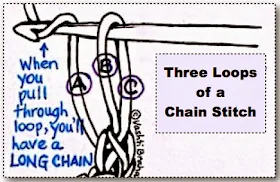 |
| Crochet is all about options. |
Nowadays, when a project requires foundation chains instead of a thicker, stretchier alternative, I choose to crochet into the chains different ways. In my crochet patterns I specify how when it matters.
Usually when I need to specify which chain loop to crochet into, it's the bottom "bump" loop (see the top grey swatch at right). This is the loop that you need to use when doing:
- The "fat-free picots" referred to in this newsletter,
- The love knot stitch, and
- The beginning row in some star stitch patterns. Below is a how-to.
Update, Mar. 15 2014: Crochet Inspirations Newsletter issue #58 takes this topic further.
Chain Stitch Anatomy 101
- Front Top Loop: the one closest to you as you're about to crochet into it.
- Back Top Loop: the one farther from you, but still the top part of the chain.
- Bottom Bump Loop: Turn the chain over to see the third strand on the bottom. It looks different, like a small bump between the two top loops.
 |
| When the crochet hook pulls "A" through loop "B-C", a loose chain will be completed. The B and C strands will form the two top loops of the chain. The A strand will be the bottom bump loop of the chain. (This image also shows the first step in crocheting a love knot.) |
You can crochet a stitch into any one or two of these loops. This is how you get the six conventional ways shown in the six swatches in the upper image (i.e., insert hook under X loop or loops of the chain, yarn over and pull yarn through). Next I'll compare four of the six options.
Four Ways to Crochet Into Foundation Chains
 |
| Option 1 gives the Starpath Scarf nice edges. |
This one gives me my favorite finished edge. It's a popular option for those in the know. Neither top loop is used, so they show completely along the finished edge. It creates the same lovely chain-loop look as the other finished edge; in other words, the bottom edge of the first row looks the same as the top edge of the last row. Makes an edging optional, and makes seaming a pleasure.
Option #1 firms up the foundation chain (fch) more than crocheting into a top loop, so depending on the project, I make my chains a bit looser. I don't find it to be more difficult to do; the challenge is in the pattern writing!
I feel that not enough crocheters notice this third bottom "bump" strand of chain stitches. Even if they do, the term for that loop is not as standardized and well known. This is the main reason I wrote this blog post.
Option #2. The top two loops (blue swatch above)
This is the way I was originally taught - under both of the top loops of the chain. It results in a finished edge of little "bump" loops because the bottom bump loop of each chain is the only loop that's not included in the next row of stitches. This option tightens up a foundation chain the most. The big reason I would choose this is if I wish to effortlessly unzip the foundation chain later (if done as described in the Burly Bias pattern). Another reason would be if I'm crocheting beads into the fchs.
 |
| Flounce Charms: Option #1 required for their Fat-Free Picots |
Option #3. Two other loops (the top back loop + the "bottom bump" loop, green swatch above)
I've met some crocheters who prefer this option because It's the recommended option in most of the how-to books, often as an improvement over Option #4. It's a bit firmer and neater looking than #4, and a bit easier than #2.
Option #4. One top loop (orange swatch): Some beginners are taught to crochet into only one top loop, which is actually the top back loop (abbreviated BL in patterns; or BLO which means "back loop only"). Crocheting into this loop of a fch is helpful for beginners, because it's easier to fish around for only one of the three loops of every chain, especially the BL—it sticks up a bit more than the other top loop (the FL). Another benefit is that the fch firms up less. It's the most discouraged option in the how-to books, though, because it can have a stringy, loopy, or messy look.
 |
| Option #4 is used for the Luckyslip Mitts. |
I use this option sometimes if I'm crocheting slip stitch ribbing that I'll be seaming with slip stitches later; and sometimes when I crochet rows on both sides of the foundation chain.
Aside from my first choice (Option #1), I also like the rarely used top front loop only - the pink swatch - instead of #2, #3, or #4. It has a stable finished feel, a flat back, and a cute nubby front.
No matter which option you choose, try to pick the same top loop(s) of every chain of the fch, or else the next chain may look weird and your finished edge look irregular.
No comments:
Post a Comment
On-topic questions are welcome!